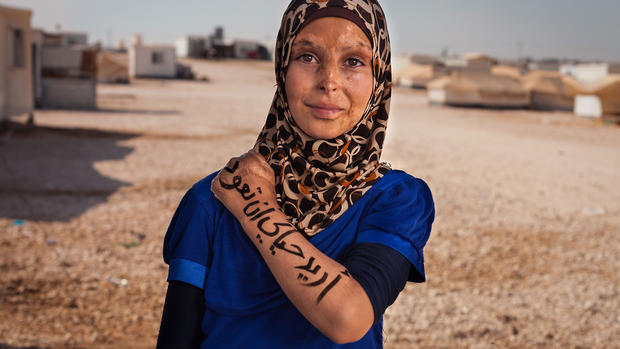Photographer aims to put a face on the Syria conflict
Eleven-year-old Huda was injured by a bomb blast near her home in Syria. Her family had to hide after the attack, and couldn't get to a hospital for nearly two days. Now a refugee in Jordan, Huda's message is simple: "I want the life I had back."
Huda is one of more than 120,000 Syrian refugees currently living in Jordan's Zaatari refugee camp. Last month, photographer Robert Fogarty traveled to the camp armed with felt-tip markers and a camera, aiming to make the refugees' voices heard. Fogarty asked them to write a message on their arms: something they wanted the world to know about their situation. Then he photographed them.
The result was a series of striking portraits, capturing what Fogarty calls the mixture of "fear and hope" that is emblematic of the refugee experience. They included a child who simply scrawled "When shall we return?" Muhammad from Zarqa who wrote: "I am not a terrorist." Fogarty was especially struck by Huda, whose smile he said outshone the burn scars on her face.
The trip was hosted by CARE International, which is helping over 110,000 Syrians and host families in Jordan get access to essential supplies and medical care.
"The suffering that Syrian refugees endure is appalling and heartbreaking," says CARE Jordan Country Director Salam Kanaan. "Through this project we wanted to highlight the voices of ordinary, innocent men, women and children whose lives have been devastated by this conflict. We hope these pictures with their simple messages make the world sit up and take notice."
More than 2 million people have fled Syria since fighting broke out in March 2011, and Jordan has taken in over a quarter of them. Senior spokesman for the United Nations High Commission on Refugees (UNHCR) in Jordan Peter Kessler calls the Syrian refugee crisis "unprecedented" in terms of the sheer scale of displacement, and the particular challenges of a region where security is "precarious."
For the thousands of refugees who now call the Zaatari camp home, Kessler says, sanitation and education remain significant challenges. Jordan's school system has not yet been able to accommodate all the school-age refugee children like Huda. Most refugees are still living in tents. While the UNHCR, who administers the camp, says food and aid needs are all met, Kessler acknowledges that the refugees are suffering emotionally in ways that cannot be quantified.
Last year, winter proved brutal for Syrian refugees. With temperatures starting to plummet again across the region, aid groups are ramping up preparations to deal with Syria's third winter amid conflict. In Jordan's camps, UNHCR will provide plastic sheeting to better insulate the emergency shelters. The agency will also provide thermal blankets, gas heaters and cylinders.
Photographer Fogarty says his aim is to help put a face on this devastating conflict.
"I think the images show the dignity of normal Syrians who've had their lives turned upside down by events," he says. "These people are just like us. They have dreams and fears. They want to protect their families, have a roof over their head and have hopes for a brighter tomorrow".
Fogarty's first experience taking photos of disaster victims started with survivors of Hurricane Katrina in New Orleans, where "people know what it's like to lose something," but along the way, he says "we found that everyone has a story." He went on to take similar photos in post-Sandy New York and tornado-ravaged Joplin, Missouri.
By using individual portraits and messages of people experiencing hardship, Fogarty says he hopes to highlight the human spirit that connects us all.
"The people in those photographs are not so different from you or I," Fogarty says. "We can't just look away because it's far away."
